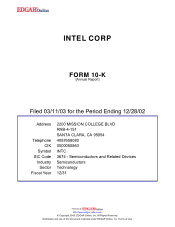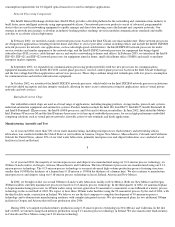Intel 2002 Annual Report Download - page 5
Download and view the complete annual report
Please find page 5 of the 2002 Intel annual report below. You can navigate through the pages in the report by either clicking on the pages listed below, or by using the keyword search tool below to find specific information within the annual report.
the Internet. Workstations offer higher performance than standard desktop PCs, especially in graphics processing and in the
ability to perform several tasks at the same time. Our strategy for the enterprise platform is to provide high-performance
processors and the best price for performance across the entire range of server and workstation market segments.
The Intel Architecture business's products include processors and board-level products based on our 32-bit Intel® architecture. This IA-32
architecture encompasses both the Intel® NetBurst™ microarchitecture (used in the Intel® Pentium® 4 and related microprocessors) and the
previous P6 microarchitecture (used in Intel® Pentium® III and related microprocessors). We also offer the 64-bit Intel® Itanium® processor
family for enterprise-class servers. In addition, we offer chipsets compatible with our microprocessor products. These chipsets improve ease of
use for our OEM customers, provide new capabilities and enable overall system performance to scale as processor performance increases.
Net revenue for the Intel Architecture operating segment made up approximately 83% of our consolidated net revenue in 2002.
Microprocessors
A microprocessor is the central processing unit (CPU) of a computer system. It processes system data and controls other devices in the
system, acting as the "brains" of the computer. One indicator of microprocessor performance is its clock speed, the rate at which its internal logic
operates, which is measured in units of hertz, or cycles processed per second. One megahertz (MHz) equals one million cycles processed per
second, and one gigahertz (GHz) equals one billion cycles processed per second. Other factors affecting chip performance include the amount of
memory storage, the speed of memory access, and the speed of communication between the CPU and the chipset. The memory stored on a chip
is measured in bytes, with 1,024 bytes equaling a kilobyte (KB), 1.049 million bytes equaling a megabyte (MB) and 1.074 billion bytes equaling
a gigabyte (GB). Cache is a memory subsystem in which frequently used data is duplicated for quick access. Second (L2) and third (L3) levels of
cache, located directly on the microprocessor for faster access or between the CPU and main memory, can also be used to further increase
overall system performance.
As of year-end 2002, we manufactured a majority of our microprocessors and chipsets using our 0.13-micron process technology. The
width of individual transistors on a chip is measured in microns and nanometers: one micron equals one millionth of a meter; one nanometer is
one thousandth of a micron, or one billionth of a meter. Decreasing the width of the transistors helps us make smaller and faster microprocessors
at a lower cost. See the discussion of manufacturing process technologies under the heading "Manufacturing, Assembly and Test" in Part I, Item
1 of this Form 10-K.
In 2002, we announced a number of new microprocessor products tailored to meet performance, price and form factor needs for computing
market segments ranging from consumer desktops to high-performance servers.
2
Desktop Platform. In 2002, the Intel Pentium 4 processor was our highest volume desktop processor. The Pentium 4 processor, based on
the Intel NetBurst microarchitecture, is optimized to deliver high performance across a broad range of business and consumer applications,
especially the latest technologies in web, interactive 3D, and streaming video and audio environments. These processors also enhance the user's
experience in many applications, such as e-Learning, Internet browsing and computer gaming.
In January 2002, we introduced the first Pentium 4 processors running at up to 2.2 GHz built on our 0.13-micron manufacturing process
technology. This technology allowed us to reduce the die size by 30% and double the size of the on-chip L2 cache memory, which enhances the
processor's performance. Throughout the year, we introduced eight additional Pentium 4 processors running at speeds of up to 2.8 GHz.
In November 2002, we introduced the Intel Pentium 4 Processor with HT Technology. This chip is the first commercial desktop
microprocessor to operate at 3 billion cycles per second, or 3 GHz. This chip is also our first desktop processor to incorporate Hyper-Threading
Technology (HT Technology), which increases system-level performance by allowing a single processor to handle two streams of data
instructions simultaneously. This capability provides system-level performance benefits in two ways: through multithreaded software (software
designed to execute different parts of a program simultaneously) or through using software in a multitasking environment. To take advantage of
the HT Technology capability, a computer system must have a processor that supports the technology, a chipset and BIOS (basic input/output
system) that use the technology, and an operating system that includes optimizations for the technology. Performance will vary depending on the
system hardware and software used.
In February 2002, we unveiled plans for our next-generation desktop microprocessor, code-named "Prescott," which is slated for
introduction in 2003. Prescott will be manufactured on our 90-nanometer process technology and will include HT Technology.
In the value PC market segment, the Intel® Celeron® processor is designed to meet the core computing needs and affordability
requirements of some value-conscious PC users. During 2002, we introduced seven new versions of the desktop Celeron processor running at
speeds ranging from 1.3 GHz to 2.2 GHz.
In March 2002, we announced the shipment of our 100 millionth boxed microprocessor through our worldwide reseller sales channel. We
launched our boxed processor program in 1994 to make our products and technical information available to smaller systems builders that cater to


















